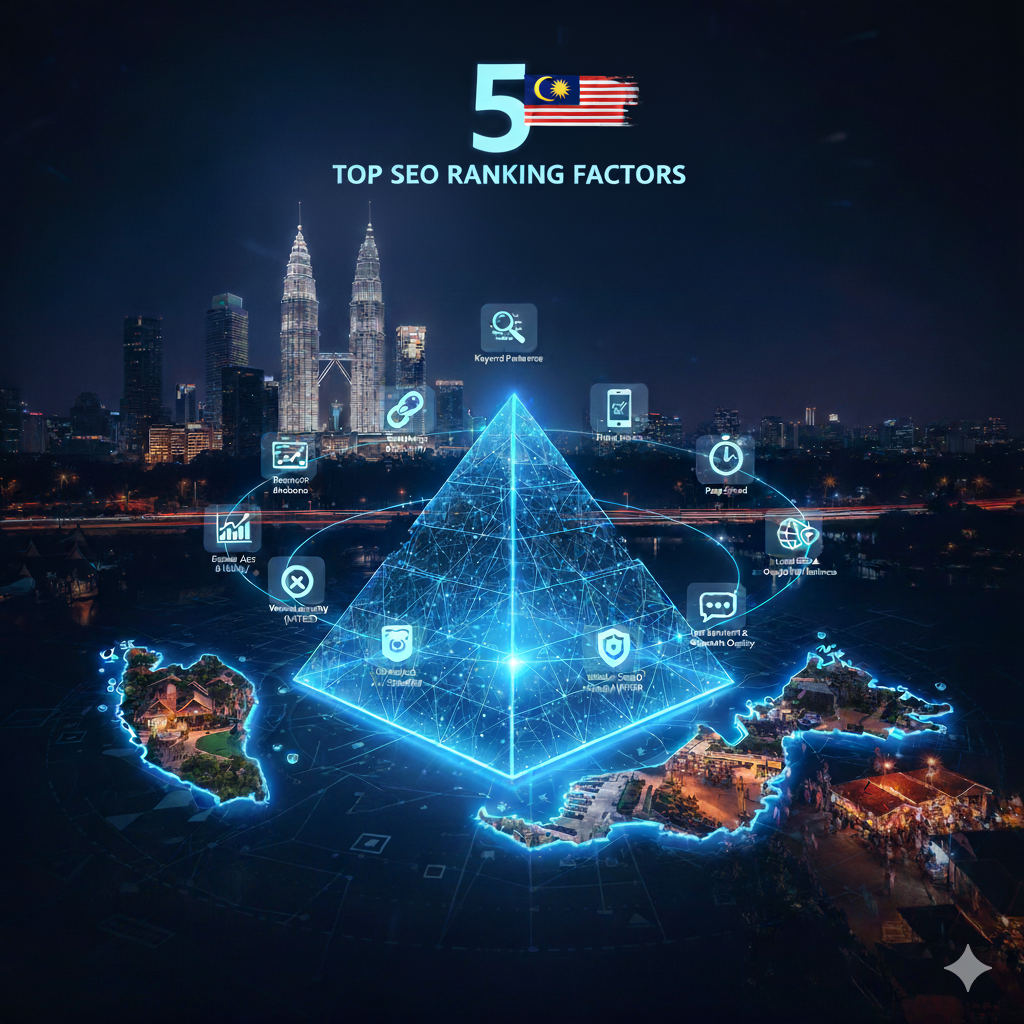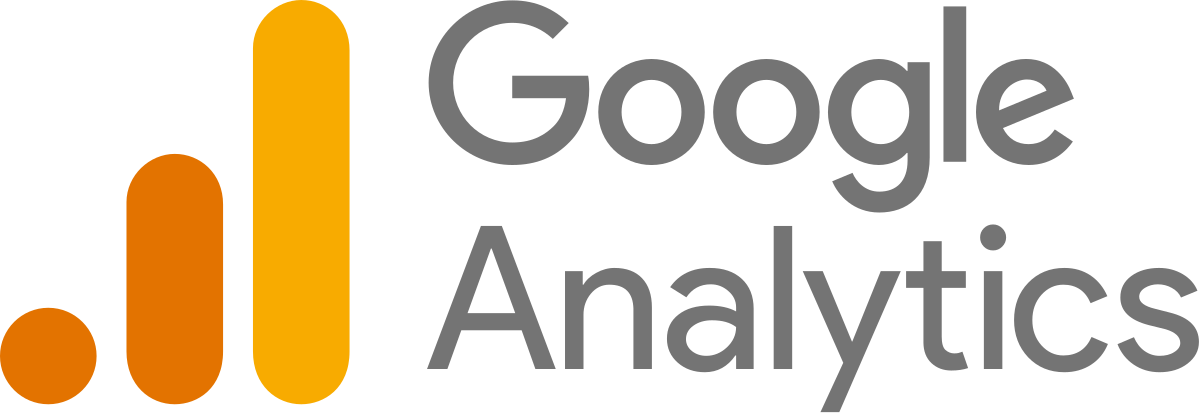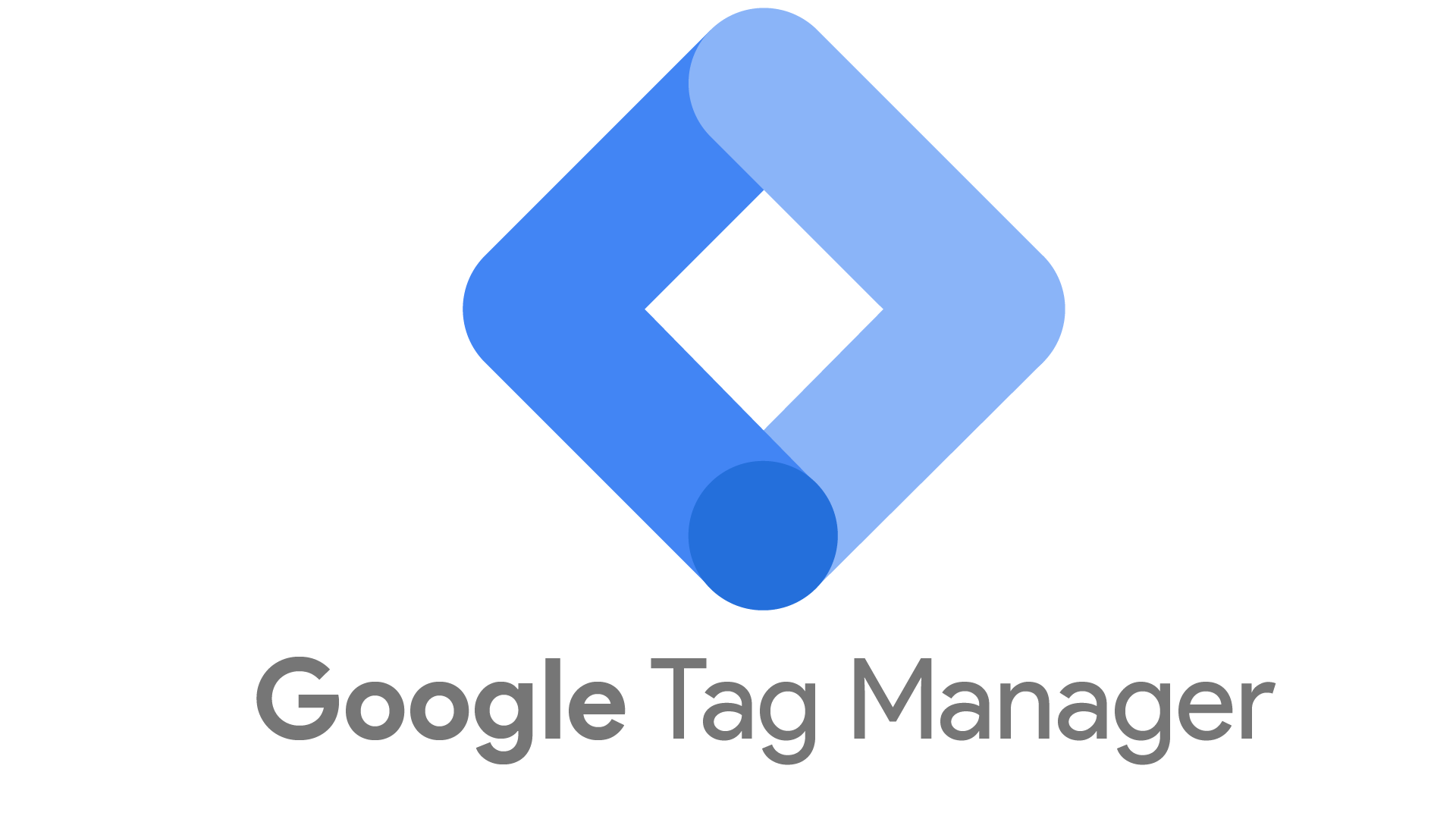
Top 5 SEO Ranking Factors for 2026
By Admin - October 02, 2025
Top 5 SEO Ranking Factors Businesses Should Apply in 2026
With 2026 around the corner, AI is taking more and more control of the SEO world. Search engine optimization isn’t the same anymore ever since AI entered the scene, and the pace of change is accelerating. The sooner businesses adapt to this new environment, the faster they’ll see meaningful results.
Hence, businesses should rethink their SEO strategies, focusing on what truly matters in this AI-driven landscape. From generative search optimization to user intent modeling and technical performance, the ranking factors shaping 2026 are very different from what worked just a few years ago.
In this guide, we break down the Top 10 SEO Ranking Factors for 2026, with a special focus on how Malaysian brands can leverage these trends to stay ahead.
1. AI Search Optimization (GEO / AEO)
AI Search Optimization is often classified into two categories: Generative Engine Optimization (GEO) or Answer Engine Optimization (AEO). It is essentially the process of optimizing content so that AI-powered search engines like Google’s AI Overviews, Perplexity, Bing Copilot, and ChatGPT Search can understand, extract, and cite your content directly inside their answers.
In 2026, this is one of the most important shifts in SEO. Instead of competing only for top organic rankings, brands now need to optimize to be featured inside AI-generated summaries. This acts as a crucial opportunity for businesses leveraging search engine optimization malaysia to reach users faster and with higher authority.
Importance of AI Search Optimization in 2026
AI Search Optimization has completely transformed the way SEO works in 2025. And honestly, we expect it to get even more complex in 2026. Things have changed so drastically that SEO specialists around the world are now calling on platforms like ChatGPT and Gemini to release their own versions of Search Console though, at this point, no one’s sure if that will actually happen.
What we do know for sure is that the way users interact with search has shifted dramatically, and the numbers speak for themselves.
|
47% of Google searches globally displayed AI Overviews in 2025. |
|
13.14% of US desktop queries triggered AI Overviews by March 2025 (up from 6.49% in January) |
|
Pew Research found 18% of searches generated AI summaries, and 88% of those included 3+ citations. |
|
BrightEdge reported Google Search usage grew 49% in one year after AI Overviews rolled out. |
Businesses that are still relying on traditional seo malaysia strategies are finding it increasingly difficult to sustain their website performance – unless they started building strong SEO foundations long before the new algorithms and updates began reshaping SEO as a whole.
Brands appearing as cited sources inside AI summaries can gain massive exposure, often outranking competitors without holding a top-3 spot.
What are the Pros and Cons of AI Search Optimization?
Pros |
Cons |
|
|
|
2. Requires high-quality, structured content |
|
3. GEO algorithms evolve rapidly and seo service providers in malaysia must adapt often |
|
4. Competitive for commercial queries |
AI Search Optimization Strategies
1. Structure content for easy extraction
-
Add concise summaries at the top of pages.
-
Use bullet lists, steps, and FAQs to make content scannable for AI engines.
2. Target conversational queries
-
Optimize headings and content to match natural language questions (e.g. “What is the best POS system for cafés in Malaysia?”).
3. Implement structured data and schema markup
-
FAQ, HowTo, Product, and Organization schema improve machine readability and citation chances.
-
Many search engine optimization agencies in Malaysia use schema as a GEO priority.
4. Keep content fresh and localized
-
Regularly update stats and adapt content for Malaysia’s multilingual market.
-
This is now a core part of seo marketing malaysia strategies.
5. Include credible sources and original insights
-
AI engines prefer trustworthy, well-cited content. Linking to government or authoritative local data boosts credibility.
2. Topical Authority and Semantic Clustering
In 2026, topical authority will become one of the most decisive factors for ranking well in search. Instead of just optimizing individual pages for single keywords, search engines now evaluate how well a website covers an entire subject area comprehensively.
The term “semantic clustering” refers to the practice of grouping related topics together and building interconnected content hubs. By doing this, brands can signal to Google and AI engines that they are a credible, in-depth authority on a specific subject.
For Malaysian brands working with an seo company, remember to ask if your provider offers this specific type of content strategy because it would make your website stand out in a saturated content environment. Google’s algorithms increasingly reward depth, context, and content structure rather than keyword stuffing or isolated blog posts.
Importance of Topical Authority and Semantic Clustering in SEO Content Strategy
Unlike humans, who read content wherever they find it interesting, search engines, LLMs, and AI models don’t process information the same way. To help them understand your website more effectively, your seo marketing agency should build a structured content ecosystem by ensuring clear topic relationships and well-defined user intent into your content strategy.
|
A 2025 Semrush study found that websites with well-structured topic clusters saw 40–60% more organic traffic growth than those using single-page targeting. |
|
Sites with strong topical authority are 3× more likely to earn AI Overview citations compared to generalist sites. |
|
Ahrefs data showed that topically authoritative sites rank for 57% more long-tail queries than competitors with similar backlink profiles. |
What are the Pros and Cons of Topical Authority and Semantic Clustering?
Pros |
Cons |
|
|
|
2. Needs high-quality content creation across multiple pages |
|
3. Measuring topical authority can be complex without the right tools |
|
4. Competitive niches require consistent publishing |
Topical Authority and Semantic Clustering Strategies
1. Create content clusters
-
Choose a core “pillar” topic (e.g., “digital marketing in Malaysia”) and build supporting articles that explore subtopics in depth.
-
Interlink these pages strategically to show search engines the topical relationships.
2. Map user intent carefully
-
Align content with different search intents: informational, commercial, and transactional.
-
This is a key tactic many seo marketing agencies are using to dominate niche searches.
3. Use semantic keywords and entities
-
Include related concepts and phrases naturally throughout your content.
-
This helps AI engines understand context and boosts citation potential.
4. Update and expand clusters regularly
-
Refresh content to reflect new trends, stats, and algorithm changes.
-
Google rewards sites that continuously develop their topic hubs.
3. High-Quality Backlinks and Digital Authority
Backlinks have always been a core part of SEO, and in 2026, they’re still one of the strongest ranking signals. As a reliable seo agency in Malaysia, we know how important quality, relevance, and authenticity are compared to the sheer volume.
Google’s algorithms (and AI-driven search engines) can now easily detect spammy link-building tactics, low-authority domains, and unnatural patterns. Instead, they reward websites that earn high-quality, contextually relevant backlinks from reputable sources.
Importance of High-Quality Backlinks
Over the years, based on our experience, high-quality content used to be the primary factor for SEO rankings. But eventually, great content alone wasn’t enough anymore. To stay competitive, websites had to combine strong content with effective link-building strategies.
For a while, some managed to trick the system using link farms and other manipulative tactics but Google quickly caught on, labeling these links as spammy and irrelevant.
In 2026, it’s no longer a choice between content or backlinks. The most successful SEO strategies are built on a powerful combination of both — publishing authoritative, valuable content and earning high-quality, relevant backlinks that strengthen your site’s credibility.
|
A 2025 Ahrefs study found that 91% of top-ranking pages had at least one backlink from a domain with a DR (Domain Rating) of 70+. |
|
SEMrush reported that high-authority backlinks can boost rankings up to 45% faster than relying on content alone. |
|
Google’s SpamBrain system and link algorithms are now better than ever at identifying manipulative link schemes. |
|
In Malaysia, sites that consistently build links from local news portals, universities, and niche blogs see up to 68% more organic visibility growth year-over-year compared to sites using outdated link farms. |
What are the Pros and Cons of High-Quality Backlinks?
Pros |
Cons |
|
|
|
2. Strategic link-building campaigns can be resource-intensive |
|
3. Requires strong content assets and outreach skills |
|
4. Risk of penalties if using outdated black-hat tactics |
Backlink Strategies for 2026
1. Create Link-Worthy Content
-
Publish original research, in-depth guides, or interactive tools.
-
Malaysian brands can use unique local data or case studies to attract seo services interest and natural links.
2. Strategic Digital PR & Collaborations
-
Partner with universities, government bodies, or industry associations to get featured on high-authority Malaysian domains.
-
This boosts both referral traffic and search engine optimization malaysia signals.
3. Leverage Thought Leadership
-
Contribute guest posts to reputable platforms.
-
Get quoted in niche roundups or expert commentary to attract editorial links.
4. Local Link Building Campaigns
-
Sponsor local events, collaborate with influencers, or support NGOs to earn natural mentions from trusted community websites.
5. Avoid Black-Hat Tactics
-
Paid link schemes, link exchanges, or mass directory submissions are now extremely risky. Google’s systems can penalize entire networks, not just individual sites.
4. Technical SEO and Page Experience
In 2026, we can confidently say that technical SEO and page experience are must-haves, making them essential ranking factors.
Search engines and AI models have become much more advanced in evaluating site health, performance, and usability. Websites that load slowly, have poor structure, or offer a frustrating user experience often struggle to rank, no matter how good their content is.
When looking for a seo service provider in Malaysia, ensure that they solidify your website with a strong technical foundation. This is because it allows great content and backlinks to actually perform. Page speed, mobile-friendliness, indexing, and clean site architecture are also factors for sustainable ranking growth.
Importance of Technical SEO and Page Experience
Technical SEO and page experience play a crucial role in reducing high bounce rates. During an online conference with Opollo, it was shared that while there are opportunities for websites ranking within the top 12 positions to be cited in AI Overviews, a low bounce rate is also a key requirement.
This is because a low bounce rate indicates that users are genuinely engaging with the content and finding what they’re looking for. On the other hand, a high bounce rate usually signals that visitors didn’t get the answers or experience they expected, causing them to leave quickly.
That’s why technical SEO and page experience are often the very first elements users encounter — before they even start consuming your content. If your site is slow, poorly structured, or difficult to navigate, most users won’t stick around long enough to see the value you’re offering.
|
A 1-second delay in page load time can reduce conversions by up to 20% (Google, 2025) |
|
Core Web Vitals are now fully integrated into ranking systems, and sites passing all CWV metrics are 24% more likely to rank in the top 3 results (Search Engine Journal, 2025) |
|
Mobile-first indexing has matured — Google crawls and ranks mobile versions of sites first by default |
|
In Malaysia, 78% of users say they leave a website if it doesn’t load within 3 seconds (MCMC Internet Users Survey, 2025) |
What are the Pros and Cons of Technical SEO and Page Experience?
Pros |
Cons |
|
|
|
2. Ongoing monitoring and maintenance |
|
3. Some optimizations can be resource-intensive |
|
4. Poor implementation can break site elements if rushed |
Technical SEO Strategies for 2026
1. Optimize Core Web Vitals
-
Improve LCP (Largest Contentful Paint), FID (First Input Delay), and CLS (Cumulative Layout Shift).
-
Compress images, enable lazy loading, and reduce render-blocking scripts.
2. Prioritize Mobile Experience
-
Design mobile-first interfaces with fast navigation.
-
Test frequently using Google’s Mobile-Friendly Tool.
3. Ensure Proper Indexing & Crawlability
-
Submit updated sitemaps to Google Search Console.
-
Fix broken links, duplicate content, and orphaned pages that block crawlers.
4. Implement Clean Site Architecture
-
Logical URL structure, breadcrumb navigation, and structured data markup.
-
Makes it easier for search engine optimization agencies and crawlers to understand your content hierarchy.
5. Secure & Accessible Site
-
HTTPS is now non-negotiable.
-
Add accessibility features (alt text, ARIA labels) to improve both UX and SEO performance.
5. Omnichannel SEO and Speed of Implementation
SEO is no longer a solo marketing activity. It now needs to be part of a broader omnichannel ecosystem that integrates content marketing, social media, video platforms, email, and even offline branding.
Omnichannel SEO is about ensuring your brand appears consistently and strategically across multiple digital touchpoints, creating a unified presence that reinforces your authority. At the same time, speed of implementation has become a critical ranking factor — because algorithm updates, AI Overviews, and generative search changes are rolling out faster than ever.
Importance of Omnichannel SEO and Speed of Implementation
For smaller brands, working with a seo marketing agency and adopting a more omnichannel approach is especially important. In 2026, if your brand doesn’t have strong online presence and influence, competing in SEO will become increasingly challenging.
|
A 2025 HubSpot report found that businesses using 3+ marketing channels saw 287% higher engagement rates compared to those using a single channel. |
|
According to Search Engine Journal, brands that implement SEO changes within 30 days of an update see up to 45% better ranking retention than those that delay. |
|
Omnichannel consistency improves trust signals, which can indirectly boost rankings through better engagement, lower bounce rates, and increased branded search. |
|
In Malaysia, 71% of consumers say they prefer brands that offer a seamless experience across multiple platforms (MDEC Digital Consumer Survey, 2025). |
What are the Pros and Cons of an Omnichannel SEO strategy?
Pros |
Cons |
|
|
|
2. Tracking performance across multiple channels can be complex |
|
3. Inconsistent messaging can harm trust if not managed carefully |
|
4. Needs reliable tech infrastructure for fast implementation |
Omnichannels Strategies for 2026
1. Create Channel-Specific SEO Strategies
-
Tailor your approach for platforms like YouTube, TikTok, LinkedIn, and Google Business Profiles.
-
Align messaging and keywords while respecting each platform’s native format.
2. Speed Up Execution with Agile SEO
-
Shorten the gap between identifying trends and implementing updates.
-
Many Malaysian brands use agile workflows with their seo company malaysia teams to respond to algorithm changes quickly.
3. Leverage First-Party Data Across Channels
-
Use email lists, CRM data, and social media insights to optimize campaigns holistically.
-
Helps personalize search experiences and boost engagement signals.
4. Unify Branding & Content Themes
-
Maintain consistent branding across ads, search, and social media.
-
This strengthens search engine optimization malaysia signals and makes your brand more memorable.
5. Cross-Team Collaboration
-
Encourage coordination between SEO, content, paid media, and development teams for faster, aligned rollouts.
Conclusion
Now that we’ve outlined the top 5 SEO ranking factors, it’s important to acknowledge that the landscape may shift again by early 2026. As much as we encourage our readers to stay updated with the latest trends, we also have to adapt and evolve alongside these changes.
That said, we don’t anticipate a complete overhaul of SEO strategies. Instead, we expect a series of strategic tweaks and adjustments will be necessary — especially once new Google algorithms and updates roll out. Staying flexible and proactive will be key to maintaining strong rankings in this rapidly changing environment.
FAQs
1. What is AI Search Optimization, and why is it important in 2026?
AI Search Optimization helps your website appear in AI-powered search results like Google AI Overviews, Gemini, and ChatGPT by optimizing for conversational queries and structured content.
In 2026, AI is driving how users search and how results are displayed. SEO agencies in Malaysia need to optimize for AI. This means structuring your content clearly, using natural language, and aligning with user intent so that AI models can understand and surface your content in conversational answers.
2. How does topical authority improve SEO rankings?
Topical authority boosts rankings by showing search engines that your site is a trusted, in-depth resource on a specific subject.
Building topical authority involves creating interconnected content clusters around a theme. This structure helps search engines and AI models understand your site’s expertise and relevance. By using semantic clustering, brands can rank for broader keyword sets and appear more often in AI Overviews.
3. Why is technical SEO and page experience so critical now?
Technical SEO and good page experience help search engines crawl your site effectively and keep users engaged, both of which are key ranking signals in 2026.
Search engines prioritize websites that load quickly, are mobile-friendly, and provide smooth navigation. A low bounce rate signals strong user satisfaction, increasing your chances of being cited in AI Overviews. This is why many businesses work with seo service malaysia experts to improve site speed, mobile responsiveness, and indexing.
4. Are backlinks still relevant in 2026?
Yes. Backlinks remain one of the strongest SEO ranking factors in 2026, but quality is more important than quantity.
Backlinks act as endorsements, signaling trust and authority. In 2026, search engines place heavier weight on relevant, high-quality backlinks from credible sources like local news portals, educational sites, and niche industry platforms.
5. What does omnichannel SEO mean?
Omnichannel SEO means integrating SEO with multiple marketing channels—like social media, video, email, and offline branding—to build a consistent and authoritative online presence.
So far, there haven’t been many companies fully adopting an omnichannel SEO approach, especially in Malaysia. However, this is quickly changing. As algorithm updates and AI search models evolve, relying on a single marketing channel is no longer sustainable.
We foresee that omnichannel SEO will soon become a mandatory SOP for brands aiming for long-term, sustainable growth. By ensuring consistent visibility and messaging across multiple platforms, businesses strengthen their search engine optimization malaysia signals and improve their chances of ranking well in both traditional search and AI-generated overviews.
6. How can Malaysian businesses prepare for SEO changes in 2026?
Malaysian businesses should focus on AI optimization, build topical authority, improve technical SEO, earn quality backlinks, and adopt omnichannel strategies.
SEO in 2026 is fast-changing. To stay ahead, businesses need to optimize for AI search, build content clusters, ensure fast and user-friendly websites, acquire high-authority backlinks, and integrate SEO across channels. Partnering with a reliable seo company malaysia gives businesses the agility and expertise needed to adapt quickly when Google and AI platforms roll out new updates.





